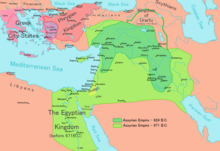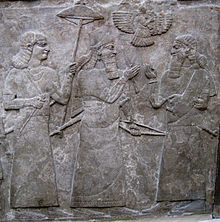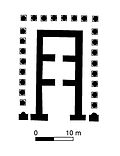Assur
Aššur ܐܫܘܪ آشور | |
 American soldiers on guard at the ruins of Ashur, 2008 | |
| Location | Saladin Governorate,Iraq |
|---|---|
| Region | Mesopotamia |
| Coordinates | 35°27′24″N43°15′45″E/ 35.45667°N 43.26250°E |
| Type | Settlement |
| History | |
| Founded | Early Dynastic Period |
| Abandoned | 3rd century AD[1] |
| Periods | EarlyBronze Agetoclassical antiquity |
| Site notes | |
| Public access | Inaccessible (in a war zone)[citation needed][needs update] |
| Official name | Ashur (Qal'at Sherqat) |
| Type | Cultural |
| Criteria | iii, iv |
| Designated | 2003 (27thsession) |
| Reference no. | 1130 |
| Region | Arab States |
| Endangered | 2003–present |
Aššur(/ˈæsʊər/;Sumerian:𒀭𒊹𒆠AN.ŠAR2KI,Assyrian cuneiform:![]() Aš-šurKI,"City of GodAššur";[2][3]Syriac:ܐܫܘܪĀšūr;Old Persian:𐎠𐎰𐎢𐎼Aθur,Persian:آشورĀšūr;Hebrew:אַשּׁוּרʾAššūr,Arabic:اشور), also known asAshurandQal'at Sherqat,was the capital of theOld Assyriancity-state (2025–1364 BC), theMiddle Assyrian Empire(1363–912 BC), and for a time, of theNeo-Assyrian Empire(911–609 BC). The remains of the city lie on the western bank of theTigris River,north of the confluence with its tributary, theLittle Zab,in what is nowIraq,more precisely in theal-Shirqat Districtof theSaladin Governorate.
Aš-šurKI,"City of GodAššur";[2][3]Syriac:ܐܫܘܪĀšūr;Old Persian:𐎠𐎰𐎢𐎼Aθur,Persian:آشورĀšūr;Hebrew:אַשּׁוּרʾAššūr,Arabic:اشور), also known asAshurandQal'at Sherqat,was the capital of theOld Assyriancity-state (2025–1364 BC), theMiddle Assyrian Empire(1363–912 BC), and for a time, of theNeo-Assyrian Empire(911–609 BC). The remains of the city lie on the western bank of theTigris River,north of the confluence with its tributary, theLittle Zab,in what is nowIraq,more precisely in theal-Shirqat Districtof theSaladin Governorate.
Occupation of the city itself continued for approximately 3,000 years,[4]from theEarly Dynastic Periodto the mid-3rd century AD, when the city was sacked by theSasanian Empire.The site is aWorld Heritage Siteand was added to that organisation's list ofsites in dangerin 2003 as a result of a proposed dam, which would flood some of the site. It has been further threatened by the conflict that erupted following theUS-led2003 invasion of Iraq.Assur lies 65 kilometres (40 mi) south of the site ofNimrudand 100 km (60 mi) south ofNineveh.
History of research[edit]
Exploration of the site of Assur began in 1898 by German archaeologists. Excavations began in 1900 byFriedrich Delitzsch,and were continued in 1903–1913 by a team from theDeutsche Orient-Gesellschaftled initially byRobert Koldeweyand later byWalter Andrae.[5][6][7][8][9]More than 16,000clay tabletswithcuneiformtexts were discovered. The German archeologists brought objects they found to Berlin enhancing the collection of thePergamon Museum.
More recently, Ashur was excavated by B. Hrouda for theLudwig Maximilian University of Munichand the Bavarian Ministry of Culture in 1990.[10]During the same period, in 1988 and 1989, the site was being worked by R. Dittmann on behalf of theDeutsche Forschungsgemeinschaft.[11]
Name[edit]
Aššuris the name of the city, of the land ruled by the city, and of itstutelary deityfrom which the natives took their name, as did the entire nation ofAssyriawhich encompassed what is today northern Iraq, north east Syria and south east Turkey. Today the Assyrians are still found throughout the Middle East, particularly inIraq,Iran,Syria,Turkey,and the Diaspora in the western world. Assur is also the origin of the namesSyriaandterms for Syriac Christians,these being originallyIndo-Europeanderivations of Assyria, and for many centuries applying only to Assyria and the Assyrians (seeEtymology of Syria) before also being applied to theLevantand its inhabitants by theSeleucid Empirein the 3rd century BC.
History[edit]
Early Bronze Age[edit]
According to the Oxford Companion to the Bible, Assur was "built on asandstonecliff on the west bank of theTigrisabout 35 km (24 mi) north of its confluence with thelower Zab River".[12]Archaeology reveals the site of the city was occupied by the middle of the 3rd millennium BC. This was still theSumerian period,beforeAssyriaemerged. The oldest remains of the city were discovered in the foundations of theIshtartemple, as well as at the Old Palace. In the subsequent period, the city was ruled by kings from theAkkadian Empire.During theThird Dynasty of Ur,the city was ruled by Assyrian governors subject to theSumerians.[13]
Old and Middle Assyrian Periods[edit]

By the time the Neo-Sumerian Ur-III dynasty collapsed at the hands of theElamitesaround the end of the 21st century BC according to the Middle Chronology and mid-20th century according to the Short Chronology following increasing raids byGutiansandAmorites.The native Akkadian-speaking Assyrian kings were now free while Sumer fell under the yoke of theAmorites.The historically unverified kingUshpiais credited with dedicating the first temple of the god Ashur in his home city, although this comes from a later inscription fromShalmaneser Iin the 13th century.[13]
In around 2000 BC,Puzur-Ashur Ifounded a new dynasty, with his successors such asIlushuma,Erishum IandSargon Ileaving inscriptions regarding the building of temples toAshur,AdadandIshtarin the city. Prosperity and independence produced the first significant fortifications in this period. As the region enjoyed relative peace and stability, trade betweenMesopotamiaandAnatoliaincreased, and the city of Ashur greatly benefited from its strategic location. Merchants would dispatch their merchandise via caravan into Anatolia and trade primarily at Assyrian colonies in Anatolia, the primary one being at Karum Kanesh (Kültepe).[13]
Shamshi-Adad I's (1813–1781 BC), Amorite ruler of the Kingdom of Upper Mesopotamia, conquered Assur and made it his religious capital (his primary capital beingEkallatumand laterShubat-Enlil). In this era, the Great Royal Palace was built, and the temple of Assur was expanded and enlarged with aziggurat.However, this empire met its end whenHammurabi,theAmoriteking ofBabylonconquered and incorporated the city into theFirst Babylonian dynastyempire following the death ofIshme-Dagan Iaround 1756 BC, while the next three Assyrian kings were viewed as vassals of Babylon.[13]
Not long after, the native kingAdasiexpelled theBabyloniansand Amorites from Assur and Assyria as a whole around 1720 BC, although little is known of his successors. Evidence of further building activity is known from a few centuries later, during the reign of a native kingPuzur-Ashur III,when the city was refortified and the southern districts incorporated into the main city defenses. Temples to the moon godSin(Nanna) and the sun godShamashwere built and dedicated through the 15th century BC. The city was subsequently subjugated by the king ofMitanni,Shaushtatarin the late 15th century, taking the gold and silver doors of the temple to his capital,Washukanni,as spoils.[13]
Ashur-uballit Iemulated his ancestor Adasi and overthrew the Mitanni empire in 1365 BC. The Assyrians reaped the benefits of this triumph by taking control of the eastern portion of the Mitanni Empire, and later also anne xingHittite,Babylonian,AmoriteandHurrianterritory. The following centuries witnessed the restoration of the old temples and palaces of Assur, and the city once more became the throne of an empire from 1365 BC to 1076 BC.Tukulti-Ninurta I(1244–1208 BC) also constructed a new temple to the goddessIshtar.TheAnu-Adadtemple was established later during the reign ofTiglath-Pileser I(1115–1075 BC). The walled area of the city in the Middle Assyrian period made up some 1.2 square kilometres (300 acres).[13]
Neo-Assyrian Empire[edit]




In theNeo-Assyrian Empire(912–605 BC), the royal residence was transferred to other Assyrian cities.Ashur-nasir-pal II(884–859 BC) moved the capital from Assur to Kalhu (Calah/Nimrud) following a series of successful campaigns and produced some of the greatest artworks in the form of colossallamassustatues and low-relief depictions of the royal court as well as battles.[14]
With the reign ofSargon II(722–705 BC), a new capital began to rise:Dur-Sharrukin(Fortress ofSargon). Dur-Sharrukin was originally planned to be built on a scale set to surpass that of Ashurnasirpal's.[15]He died in battle and his son and successorSennacherib(705–682 BC) abandoned the city, choosing to magnify Nineveh as his royal capital. The city of Ashur remained the religious center of the empire and continued to be revered as the holy crown of the empire, due to its temple of the national godAshur.[16]
In the reign ofSennacherib(705–682 BC), the House of the New Year,Akitu,was built, and the festivities celebrated in the city. Many of the kings were also buried beneath the Old Palace while some queens were buried in the other capitals such as the wife of Sargon, Ataliya. The city was sacked and largely destroyed during the decisivebattle of Assur,a major confrontation between theAssyrianandMedianarmies.[17][18]
Achaemenid Empire[edit]
After the Medes were overthrown by thePersiansas the dominant force in ancient Iran, Assyria was ruled by thePersianAchaemenid Empire(asAthura) from 549 BC to 330 BC (seeAchaemenid Assyria). The Assyrians of Mada (Media) andAthura(Assyria) had been responsible for gold and glazing works of the palace and for providing Lebanese cedar timber, respectively. The city and region of Ashur had once more gained a degree of militaristic and economic strength. Along with the Assyrians in Mada, a revolt took place in 520 BC but ultimately failed. Assyria seems to have recovered dramatically, and flourished during this period. It became a major agricultural and administrative centre of the Achaemenid Empire, and its soldiers were a mainstay of the Persian Army.[19]
Parthian Empire[edit]

The city revived during theParthian Empireperiod, particularly between 150 BC and 270 AD, its population expanding and it becoming an administrative centre of Parthian-ruledAssuristan.AssyriologistsSimo ParpolaandPatricia Cronesuggest Assur may have had outright independence in this period. New administrative buildings were erected to the north of the old city, and a palace to the south. The old temple dedicated to the national god of the Assyrians Assur (Ashur) was rebuilt, as were temples to other Assyrian gods.
AssyrianEastern Aramaicinscriptions from the remains of Ashur have yielded insight into the Parthian-era city with Assyria having its own Mesopotamian AramaicSyriacscript, which was the same in terms of grammar and syntax as that found atEdessaand elsewhere in the state ofOsroene.
German semiticist Klaus Beyer (1929-2014) published over 600 inscriptions from Mesopotamian towns and cities including Ashur,Dura-Europos,Hatra,Gaddala,TikritandTur Abdin.Given that Christianity had begun to spread amongst the Assyrians throughout the Parthian era, the original Assyrian culture and religion persisted for some time, as proven by the inscriptions that include invocations to the godsAshur,Nergal,Nanna,Ishtar,TammuzandShamash,as well as mentions of citizens having compound names that refer to Assyrian gods, such as ʾAssur-ḥēl (Ashur [is] my strength), ʾAssur-emar (Ashur decreed/commanded), ʾAssur-ntan (Ashur gave [a son]), and ʾAssur-šma' (Ashur has heard; cf.Esarhaddon).[20]
The Roman historianFestuswrote in about 370 that in AD 116Trajanformed from his conquests east of theEuphratesthe new Roman provinces of Mesopotamia andAssyria.The existence of the latter Roman province is questioned by C.S. Lightfoot and F. Miller.[21][22]In any case, just two years after the province's supposed creation, Trajan's successorHadrianrestored Trajan's eastern conquests to the Parthians, preferring to live with him in peace and friendship.[23]
There were later Roman incursions into Mesopotamia underLucius Verusand underSeptimius Severus,who set up the Roman provinces ofMesopotamiaand the Neo-Assyrian kingdom ofOsroene.
Assur was captured and sacked byArdashir Iof theSasanian Empirec.240 AD, whereafter the city was largely destroyed and much of its population was dispersed.[1]
Threats to Assur[edit]
The site was put onUNESCO'sList of World Heritage in Dangerin 2003, at which time the site was threatened by a looming large-scale dam project that would have submerged the ancient archaeological site.[24][25]The dam project was put on hold shortly after the2003 invasion of Iraq.
The territory around the ancient site was occupied by theIslamic State of Iraq and the Levant(ISIL) in 2015. Since ISIL haddestroyeda number of ancient historical sites, including the cities ofHatra,Khorsabad,andNimrud,fears rose that Assur would be destroyed too. According to some sources, the citadel of Assur was destroyed or badly damaged in May 2015 by members of ISIL usingimprovised explosive devices.[26]AnAPreport from December 2016 after the Iraqi forces had retaken the area, said that the militants tried to destroy the city's grand entrance arches, but they remained standing and a local historian described the damage as "minor".[27]
As of February 2023, a German archaeological team from Munich has resumed work at Assur. The work is focusing on the New City.
See also[edit]
- Ashur (god)andAshurism
- Chronology of the ancient Near East
- Cities of the ancient Near East
- Kings of Assyria
- Short chronology timeline
- Assyrian homeland
Notes[edit]
- ^abRadner 2015,pp. 7, 19.
- ^Also phonetically𒀀𒇳𒊬a-šur4 or𒀸𒋩aš-šurSumerian dictionary entry Aššur (GN)
- ^Pongratz-Leisten, Beate (2015).Religion and Ideology in Assyria.Walter de Gruyter GmbH & Co KG. p. 110.ISBN978-1-61451-426-8.
- ^Radner 2015,p. 2.
- ^Walter Andrae, Der Anu-Adad-Tempel in Assur, JC Hinrichs, 1909, (1984 reprintISBN3-7648-1805-0)
- ^Walter Andrae, Die Stelenreihen in Assur, JC Hinrichs, 1913, (1972 reprintISBN3-535-00587-6)
- ^Walter Andrae, Die archaischen Ischtar-Tempel in Assur, JC Hinrichs, 1922, (1970 reprintISBN3-7648-1806-9)
- ^Walter Andrae, Hethitische Inschriften auf Bleistreifen aus Assur, JC Hinrichs, 1924
- ^Walter Andrae, Das wiedererstandene Assur, 1938, JC Hinrichs, (1977 reprintISBN3-406-02947-7)
- ^Excavations in Iraq 1989–1990, Iraq, vol. 53, pp. 169-182, 1991
- ^R. Dittmann, Ausgrabungen der Freien Universitat Berlin in Ashur und Kar-Tukulti-Ninurta in den Jahren 1986-1989,MDOG,vol. 122, pp. 157–171, 1990
- ^Metzger, Bruce M.; Coogan, Michael D. (1993). "Assyria".The Oxford Companion to the Bible.Oxford: Oxford University Press. pp. 63–64.
- ^abcdefMark, Joshua J. (2014-06-30)."Ashur".World History Encyclopedia.Retrieved2023-03-14.
- ^Mark, Joshua J. (2014-08-03)."Kalhu / Nimrud".World History Encyclopedia.Retrieved2023-03-14.
- ^Mark, Joshua J. (2014-07-05)."Dur-Sharrukin".World History Encyclopedia.Retrieved2023-03-14.
- ^A Companion to the Archaeology of the Ancient Near East"In 614 BC Assur was conquered by the Medes under kingCyaxares(625-585 BC) "
- ^A Companion to the Archaeology of the Ancient Near East"In 614 BC Assur was conquered by the Medes under kingCyaxares(625-585 BC) "
- ^The Fall and Rise of Jerusalem: Judah Under Babylonian Rule"the Medes left Arrapha, attacked Kalhu (Nimrud) and Ninuwa (Nineveh), and continued rapidly northward to capture the nearby city of Tarbisu. Afterward, they went back down the Tigris and laid siege to the city of Assur. The Babylonian army came to the aid of the Medes only after the Medes had begun the decisive offensive against the city, capturing it, killing many of its residents, and taking many others captive."
- ^"Assyrians after Assyria".Nineveh. 4 September 1999.Archivedfrom the original on 14 July 2011.Retrieved19 June2011.
- ^Beyer 1998,p. 155
- ^C. S. Lightfoot, "Trajan's Parthian War and the Fourth-Century Perspective" inThe Journal of Roman Studies,Vol. 80 (1990), pp. 115-126
- ^Simon Grote, "Another look at theBreviariumof Festus "inThe Classical Quarterly,Volume 61, Issue 2 (December 2011), pp. 704-721
- ^Theodore Mommsen,Römische Geschichte(Berlin 1885), vol. V (Die Provinzen von Caesar bis Diocletian), p. 403
- ^UNESCO World Heritage in Danger 2003
- ^At the Iraqi Site of Assur, Ancient History Stands at Risk of Destruction - Smithsonian Magazine - January 2022
- ^Mezzofiore, Gianluca; Limam, Arij (28 May 2015)."Iraq: Isis 'blows up Unesco world heritage Assyrian site of Ashur' near Tikrit".International Business Times.Retrieved24 August2015.
- ^"Iraq Assur | AP Archive".aparchive.2016-12-11.Retrieved2019-03-25.
References[edit]
- Beyer, Klaus (1998).Die aramäischen Inschriften aus Assur, Hatra und dem übrigen Ostmesopotamien.Germany.
{{cite book}}:CS1 maint: location missing publisher (link) - Walter Andrae:Babylon. Die versunkene Weltstadt und ihr Ausgräber Robert Koldewey. de Gruyter, Berlin 1952.
- Stefan Heidemann:Al-'Aqr, das islamische Assur. Ein Beitrag zur historischen Topographie Nordmesopotamiens.In: Karin Bartl and Stefan hauser et al. (eds.):Berliner Beiträge zum Vorderen Orient. Seminar fur Altorientalische Philologie und Seminar für Vorderasiatische Altertumskunde der Freien Universität Berlin, Fachbereich Altertumswissenschaften.Dietrich Reimer Verlag, Berlin 1996, pp. 259–285
- Eva Cancik-Kirschbaum: Die Assyrer. Geschichte, Gesellschaft, Kultur. C.H.Beck Wissen, München 2003.ISBN3-406-50828-6
- Olaf Matthes: Zur Vorgeschichte der Ausgrabungen in Assur 1898-1903/05. MDOG Berlin 129, 1997, 9-27. ISSN 0342-118X
- Peter A. Miglus: Das Wohngebiet von Assur, Stratigraphie und Architektur. Berlin 1996.ISBN3-7861-1731-4
- Susan L. Marchand: Down from Olympus. Archaeology and Philhellenism in Germany 1750–1970. Princeton University Press, Princeton 1996.ISBN0-691-04393-0
- Conrad Preusser: Die Paläste in Assur. Gebr. Mann, Berlin 1955, 1996.ISBN3-7861-2004-8
- Friedhelm Pedde,The Assur-Project. An old excavation newly analyzed, in: J.M. Córdoba et al. (Ed.), Proceedings of the 5th International Congress on the Archaeology of the Ancient Near East, Madrid, April 3–8, 2006. Universidad Autónoma de Madrid Ediciones, Madrid 2008, Vol. II, 743–752.https:// jstor.org/stable/41147573
- Steven Lundström, From six to seven Royal Tombs. The documentation of the Deutsche Orient-Gesellschaft excavation at Assur (1903-1914) – Possibilities and limits of its reexamination, in: J.M. Córdoba et al. (Ed.), Proceedings of the 5th International Congress on the Archaeology of the Ancient Near East, Madrid, April 3–8, 2006. Universidad Autónoma de Madrid Ediciones, Madrid 2008, Vol. II, 445–463.
- Friedhelm Pedde,The Assur-Project: A new Analysis of the Middle- and Neo-Assyrian Graves and Tombs, in: P. Matthiae – F. Pinnock – L. Nigro – N. Marchetti (Ed.), Proceedings of the 6th International Congress on the Archaeology of the Ancient Near East, May, 5th-10th 2008, "Sapienza" – Università di Roma. Harrassowitz, Wiesbaden 2010, Vol. 1, 913–923.
- Barbara Feller, Seal Images and Social Status: Sealings on Middle Assyrian Tablets from Ashur, in: P. Matthiae – F. Pinnock – L. Nigro – N. Marchetti (Ed.), Proceedings of the 6th International Congress on the Archaeology of the Ancient Near East, May, 5th-10th 2008, "Sapienza" – Università di Roma. Harrassowitz, Wiesbaden 2010, Vol. 1, 721–729.
- Friedhelm Pedde,The Assur Project: The Middle and Neo-Assyrian Graves and Tombs, in: R. Matthews – J. Curtis (Ed.), Proceedings of the 7th International Congress on the Archaeology of the Ancient Near East, London 2010. Harrassowitz, Wiesbaden 2012, Vol. 1, 93–108.
- Friedhelm Pedde,The Assyrian heartland, in: D.T. Potts (Ed.), A Companion to the Archaeology of the Ancient Near East. Wiley-Blackwell, Chichester 2012, Vol. II, 851–866.
- Radner, Karen (2015).Ancient Assyria: A Very Short Introduction.New York:Oxford University Press.ISBN978-0-19-871590-0.OCLC1202732830.
External links[edit]
- Schippmann, K. (1987). "ASSYRIA iii. Parthian Assur".Encyclopaedia Iranica, Vol. II, Fasc. 8.pp. 816–817.
- Assyrian origins: discoveries at Ashur on the Tigris: antiquities in the Vorderasiatisches Museum, Berlin,an exhibition catalog from The Metropolitan Museum of Art Libraries (fully available online as PDF), which contains material on Assur
- Friedhelm Pedde,Recovering Assur. From the German Excavations of 1903–1914 to today's Assur Project in Berlin[1]
- 25th-century BC establishments
- Populated places established in the 3rd millennium BC
- Populated places disestablished in the 3rd century
- 1898 archaeological discoveries
- Amorite cities
- Ancient Assyrian cities
- Archaeological sites in Iraq
- Buildings and structures destroyed by ISIL
- History of Saladin Governorate
- World Heritage Sites in Danger
- World Heritage Sites in Iraq
- Early Period (Assyria)
- Former kingdoms
- Populated places destroyed during wars




